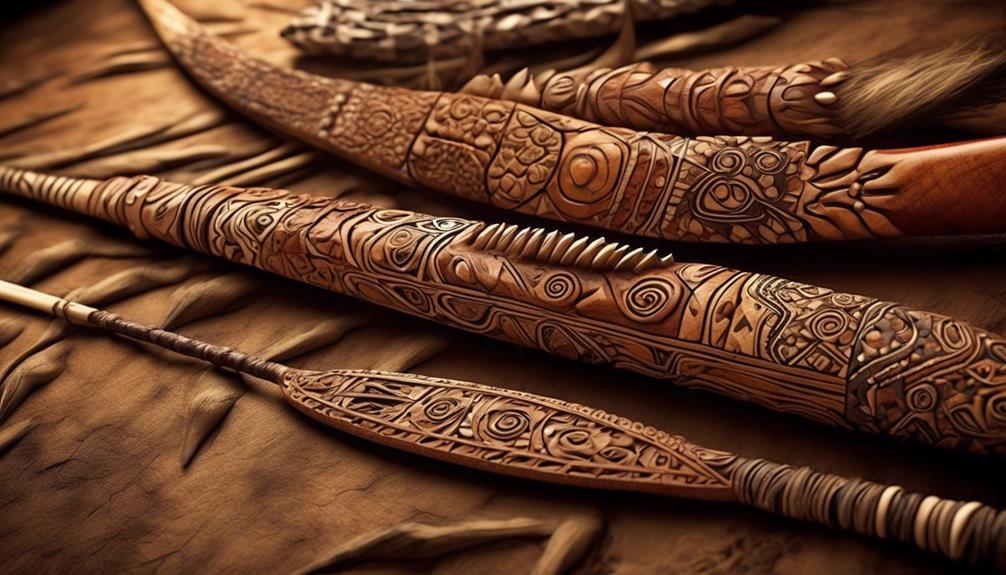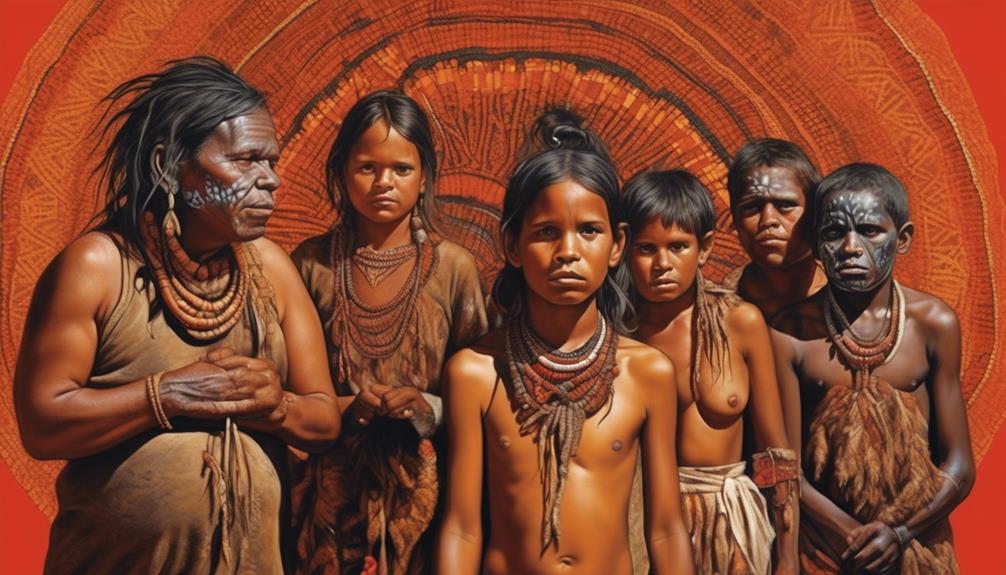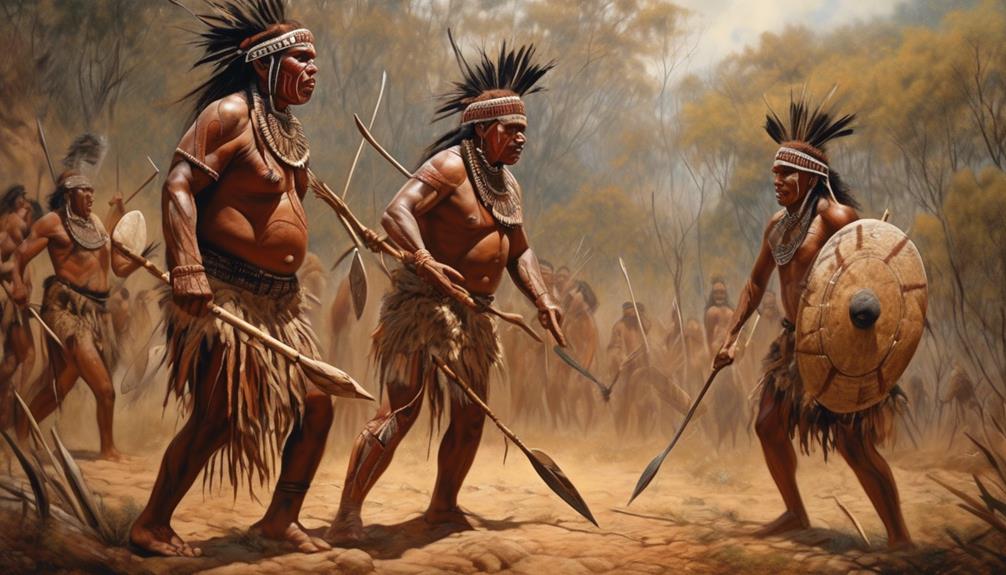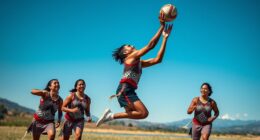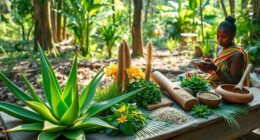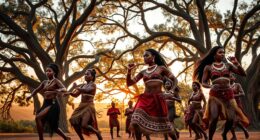When exploring the history of Indigenous Australians, it is fascinating to learn about the diverse range of weapons they utilized for hunting, warfare, and protection.
From spears and boomerangs to clubs and throwing sticks, the arsenal of traditional Aboriginal weapons is both diverse and impressive.
But what specific techniques and tools did they use for close combat? And how did they adapt to modern firearms in the face of colonization and changing landscapes?
Join us as we uncover the fascinating world of Aboriginal weaponry and the ingenuity of its wielders.
Key Takeaways
- Aboriginal Australians used a variety of traditional hunting weapons including spears, boomerangs, and woomeras.
- Boomerangs were used for both hunting and close combat, showcasing the versatility of these weapons.
- Spears were utilized for short and long-range hunting as well as close combat situations, emphasizing accuracy and force in throwing techniques.
- Aboriginal Australians displayed remarkable skill and precision in engaging targets from a distance, using both boomerangs and spears.
Traditional Hunting Weapons
Aboriginal Australians used a variety of traditional hunting weapons to capture prey, including spears, boomerangs, and woomeras. Boomerangs, although popularly known for their ability to return when thrown, were also used for hunting. Hunters would skillfully throw boomerangs in a way that caused them to hover over the ground, making it difficult for prey to detect them. Once in close range, the boomerang would be aimed at the prey, inflicting a swift and lethal blow. This technique required precision and mastery, showcasing the deep understanding of aerodynamics and hunting strategies possessed by Aboriginal Australians.
Spear throwing techniques were also crucial for successful hunting. Spears were used for both short and long-range hunting, and various throwing techniques were employed based on the type of prey and the distance. The accuracy and force with which the spears were thrown determined the success of the hunt. These techniques were honed through years of practice and were passed down through generations, highlighting the rich tradition and expertise of Aboriginal hunting methods.
Understanding and appreciating these traditional hunting techniques allows us to recognize the ingenuity and resourcefulness of Aboriginal Australian culture.
Tools for Close Combat
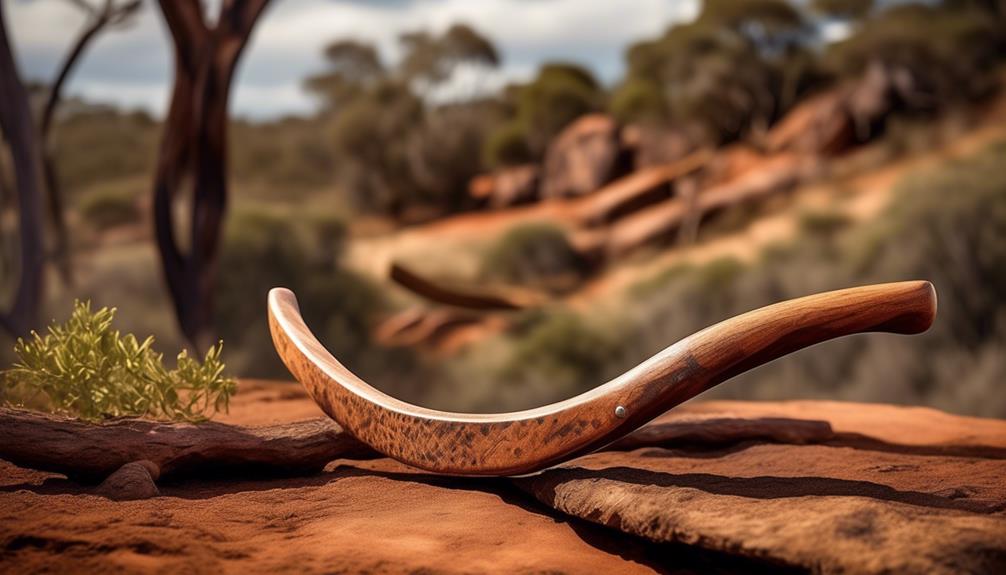
Close combat situations required a shift from traditional hunting techniques to the utilization of specialized tools for swift and effective engagement. In Aboriginal Australian culture, boomerangs weren't only used for hunting but also for close combat. Boomerang techniques were honed for both offensive and defensive purposes in combat. When thrown with precision, a boomerang could incapacitate an opponent, and in close quarters, it could be used as a club-like weapon. The skillful handling of boomerangs in combat required extensive training and dexterity.
Spear fighting techniques were also crucial in close combat situations. Spears were versatile weapons that allowed for both thrusting and throwing, providing a means to engage adversaries at various distances. The techniques for using spears in combat were refined over generations, emphasizing accuracy, speed, and the ability to swiftly maneuver in battle.
The tools for close combat used by Aboriginal Australians were a testament to their resourcefulness and adaptability in different situations. The mastery of boomerang and spear fighting techniques demonstrates the ingenuity and strategic prowess of Aboriginal Australians in navigating close combat scenarios.
Throwing Weapons
Utilizing a variety of throwing weapons, the Aboriginal Australians displayed remarkable skill and precision in engaging targets from a distance.
Boomerangs, iconic to Indigenous Australian culture, were used not only for hunting but also as ceremonial objects. These throwing sticks were designed to return to the thrower if properly launched, requiring sophisticated techniques and knowledge of aerodynamics. The boomerang's unique shape and airfoil design allowed it to travel impressive distances with astonishing accuracy.
Indigenous spear throwing was another essential skill, with spears serving as both hunting weapons and defensive tools. The Woomera, a spear-throwing device, significantly increased the velocity and distance a spear could travel, enhancing hunting strategies. The Woomera also allowed for more accurate and forceful throws, giving Aboriginal Australians an advantage when engaging prey or enemies from a distance.
Impact Weapons

Spear throwing, a fundamental skill for Aboriginal Australians, extended beyond hunting and defense to include the use of impact weapons. Impact weapons, such as clubs and boomerangs, were crucial tools for various tasks, including hunting, warfare, and ceremonial purposes. The construction of these weapons reflected the deep understanding of the environment and available resources.
| Impact Weapons | Boomerang Techniques | Club Construction |
|---|---|---|
| Boomerangs | Used for hunting and ceremonial purposes. | Crafted from hardwood and carefully shaped to ensure aerodynamic flight. |
| Nulla Nullas | Used for hunting and defense. | Carved from dense woods, some with intricate carvings for ceremonial use. |
| Waddies | Used for close combat and hunting. | Crafted from durable hardwood and often decorated with symbolic carvings. |
Boomerang techniques were passed down through generations, teaching precise throwing methods to maximize accuracy and effectiveness. Club construction involved the careful selection of materials and the application of intricate carving techniques to create weapons that were not only functional but also culturally significant. Understanding the significance of these impact weapons provides insight into the resourcefulness and ingenuity of Aboriginal Australians.
Adaptation of Modern Firearms
When examining the adaptation of modern firearms among Aboriginal Australians, one can discern a complex interplay of cultural tradition and the impact of external influences.
The integration of firearms into Aboriginal communities has raised important ethical considerations and has led to the modification of these weapons to align with cultural norms and hunting practices.
The cultural significance of firearms within Aboriginal communities can't be overstated. While the introduction of firearms has undoubtedly transformed traditional hunting methods, it has also brought about a need for careful navigation of ethical considerations.
Aboriginal communities have grappled with the integration of firearms, seeking to maintain cultural integrity while adapting to the changing landscape of hunting and self-defense. This process has led to the modification of firearms, not only in terms of physical alterations but also in the development of new hunting techniques and ethical guidelines.
The delicate balance between cultural tradition and external influence continues to shape the way firearms are utilized within Aboriginal communities, highlighting the importance of ongoing dialogue and understanding in this complex adaptation process.
Frequently Asked Questions
What Are the Spiritual and Cultural Significance of Traditional Aboriginal Hunting Weapons?
The spiritual and cultural significance of traditional Aboriginal hunting weapons encompasses a deep connection to the land and ancestral traditions. These close combat tools, often made from natural materials, hold immense value in preserving hunting and combat practices unique to various tribes.
They serve as more than just throwing or impact weapons; they embody a way of life and a connection to the past. Even in the presence of modern firearms, these traditional weapons continue to play a pivotal role in Aboriginal hunting practices.
How Did Aboriginal Australians Make Their Close Combat Tools and What Materials Were Commonly Used?
Crafting tools and selecting materials were crucial for close combat tactics among Aboriginal Australians. They honed their skills in making weapons from natural resources, such as wood, stone, and animal parts.
Were There Any Unique Throwing Weapons Used by Specific Aboriginal Tribes or Groups?
Unique throwing weapons used by specific Aboriginal tribes or groups hold cultural significance and were integral to traditional practices. These impact weapons, often made from locally sourced materials, were expertly crafted for hunting and defense.
While modern firearms have replaced some of these tools, the art of making and using close combat tools remains an important part of Aboriginal heritage.
What Impact Weapons Were Favored by Aboriginal Australians and How Were They Used in Hunting and Combat?
Impact weapons favored by Aboriginal Australians included boomerangs, nulla nullas, and woomeras. These traditional materials were used in hunting and combat, demonstrating sophisticated hunting techniques and combat strategies.
The cultural significance of these weapons is rooted in spiritual beliefs and ancestral traditions. The impact weapons were essential tools for survival and played a vital role in shaping the Aboriginal Australian way of life.
How Did the Adaptation of Modern Firearms Impact the Traditional Hunting and Combat Practices of Aboriginal Australians?
The impact of colonization brought about significant changes in Aboriginal traditional practices. The adaptation of modern firearms profoundly influenced the traditional hunting and combat practices of Aboriginal Australians. This resulted in a shift from traditional weapons to modern ones.
Despite this, Aboriginal resistance and efforts to preserve their cultural heritage have played a crucial role in maintaining their traditional practices and resisting the overwhelming influence of modern weaponry.
Conclusion
In conclusion, the traditional hunting weapons of Aboriginal Australians were diverse and effective, showcasing their resourcefulness and ingenuity.
From tools for close combat to throwing and impact weapons, their arsenal was well-suited for survival in the harsh Australian environment.
While modern firearms have been adapted for hunting, the legacy of these traditional weapons lives on, offering a glimpse into the rich cultural and historical significance of Aboriginal Australian weaponry.
Mary is a passionate writer who brings creativity and a fresh perspective to our team. Her words have the power to captivate and inspire, making her an essential contributor to our content. Mary’s commitment to storytelling and dedication to promoting Indigenous culture ensures that her work touches the hearts of our readers. We’re fortunate to have her as part of our team.
